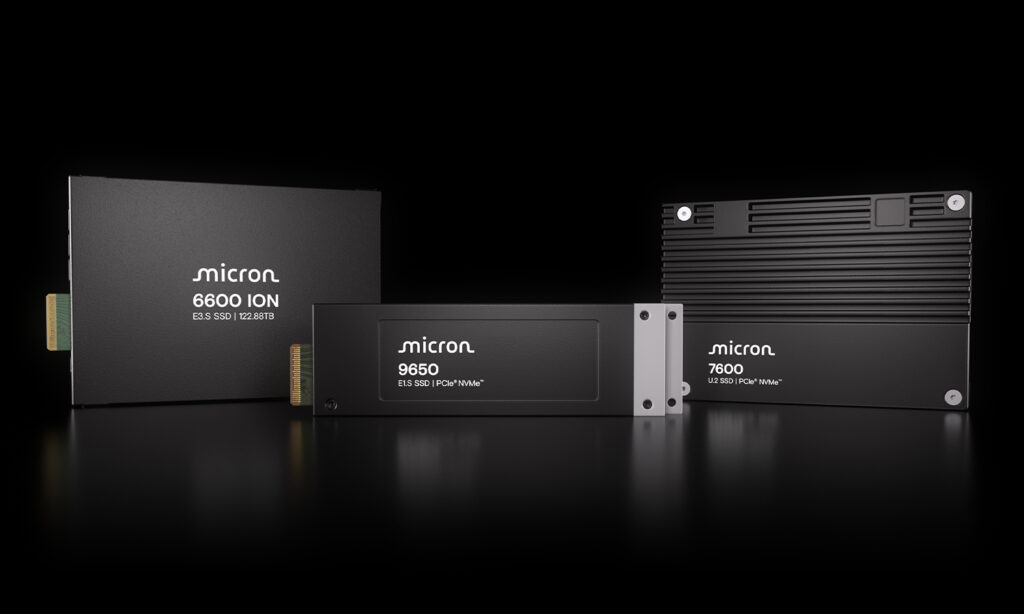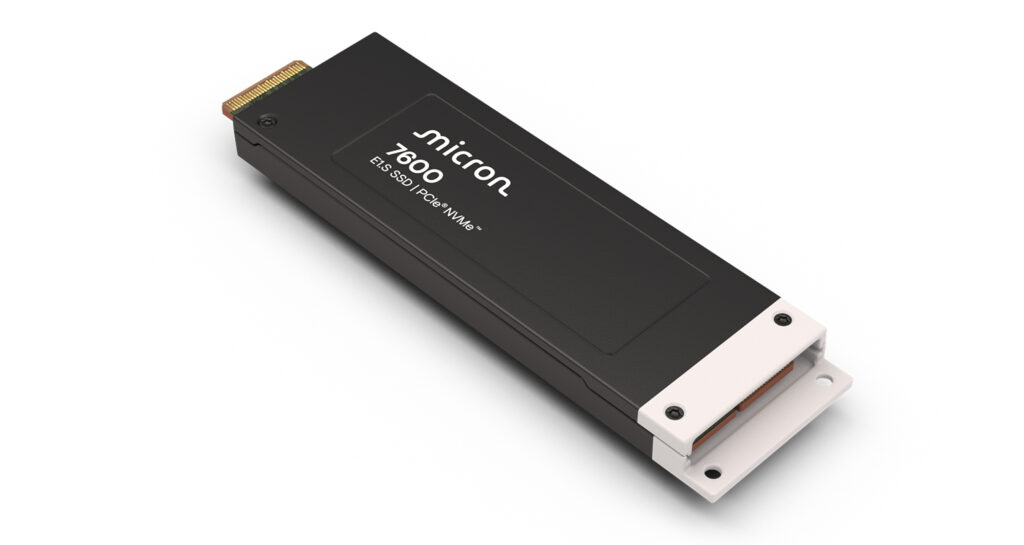Micron has introduced SSDs designed to address the growing storage demands of modern workloads. The new lineup comprises the 6600 ION, 7600, and 9650, offering a tiered approach to AI data infrastructure, with each drive optimized for a specific phase: ingestion, transformation, or inference. Each drive is built using Micron’s latest 9th-generation NAND and backed by components it makes entirely in-house, from the controller and DRAM to the firmware and manufacturing. It’s a fully integrated approach that helps Micron squeeze out more performance, efficiency, and reliability across the board.

Micron 6600 ION: High-Capacity Storage
The Micron 6600 ION is designed for environments where massive data volumes are generated and ingested continuously, typical of IoT systems, sensors, and enterprise logging infrastructure. It is the first SSD to feature a 122TB capacity in the E3.S form factor, and an even larger 245TB version is expected to be released in early 2026. Built using G9 QLC NAND and operating over a PCIe Gen5 x4 interface compliant with NVMe 2.0d, this drive is optimized for high-density deployments that also aim to reduce power consumption and space.

Performance-wise, the 6600 ION delivers up to 14GB/s in sequential reads and up to 3GB/s in sequential writes, with random read throughput reaching 2 million IOPS. Write performance is more modest, reflecting its use of QLC flash, with random write speeds ranging from 40,000 to 100,000 IOPS, depending on workload size and depth.
Even with these performance constraints, its real value comes from power and space efficiency. A 36U rack filled with these drives can deliver up to 88.5PB of storage, which is three times the density of HDD-based equivalents. Moreover, it has a peak power of just 25 watts per drive (4.92TB per watt). Compared to traditional HDD setups, this equates to a 651 megawatt-hour energy saving per exabyte deployed, along with reductions in cooling needs.
The drive is offered in both U.2 and E3.S form factors, with capacities from 30.72TB up to 122.88TB at launch. Endurance ratings show 1 DWPD for sequential workloads and between 0.3 and 0.075 DWPD for more random-access patterns. It also meets key data center reliability standards, including 2.5 million hours MTTF and an unrecoverable bit error rate under one sector per 10^17 bits read. Security features include CNSA 2.0-compliant firmware updates, dual-signed firmware, and optional FIPS 140-3 Level 2 certification, making it suitable for sensitive environments.
Micron 7600: Low Latency and Responsiveness
While the 6600 ION targets bulk capacity, the Micron 7600 is engineered for responsive, predictable performance, making it ideal for AI workloads that involve real-time data transformation or preprocessing. It utilizes G9 TLC NAND and a PCIe Gen5 x4 interface, delivering up to 12GB/s in sequential reads and 7GB/s in writes. Random read throughput peaks at 2.1 million IOPS, with mixed workloads (70% read/30% write) reaching up to 1.1 million IOPS.
The 7600 series comes in two endurance classes: PRO for read-intensive environments (1 DWPD) and MAX for mixed-use workloads (3 DWPD). Capacities range from 1.92TB to 15.36TB in the PRO lineup and 1.6TB to 12.8TB in the MAX series. It supports multiple form factors, including U.2 (15 mm), E1.S (9.5 mm and 15 mm), and E3.S 1T (15 mm), giving data center operators flexibility in deployment.

Micron claims latency below 1 millisecond at 99.9999% of operations, significantly outperforming its Gen5 competitors. Testing with RocksDB workloads revealed up to 59% better 99th percentile latency and up to 78% improved power efficiency over similar drives from other companies. For reliability, it features power loss protection, end-to-end data path protection, and a 2.5 million-hour MTTF. Security remains a priority, with support for TCG Opal, SPDM 1.2, and CNSA 2.0-compliant firmware handling.
Micron 9650: PCIe Gen6 Performance for AI Training and Inference
At the high-performance end of the spectrum is the Micron 9650, the first PCIe Gen6 SSD designed for data centers. This drive is purpose-built for AI model training and real-time inference, where both speed and sustained throughput are critical. With sequential read speeds reaching 28GB/s (double that of Gen5 drives) and random read performance hitting 5.5 million IOPS, the 9650 is in a category of its own. Write throughput is equally impressive, with sequential writes at 14GB/s and random writes reaching up to 900,000 IOPS.

The 9650 is available in PRO (1 DWPD) and MAX (3 DWPD) versions, supporting capacities ranging from 6.4TB to 30.72TB. It’s offered in E3.S and E1.S form factors, including a 9.5 mm version optimized for liquid cooling. This makes it ideal for AI servers already using liquid cooling for CPUs and GPUs, and it helps maintain power efficiency even under maximum load. The drive draws 25 watts at peak performance, offering up to double the power efficiency of Gen5 drives in terms of throughput per watt.
Testing conducted with Astera Labs and NVIDIA showcased the drive’s real-world performance: two 9650 SSDs feeding data to an NVIDIA H100 GPU via a Scorpio Gen6 switch achieved a sustained transfer rate of 56 GB/s using GPU Direct Storage. This makes the 9650 certainly well-equipped to handle next-gen data center infrastructure.
The drive also features security and reliability enhancements, including power loss protection, end-to-end data path integrity, and FIPS 140-3 L2 compliance. Firmware security features include CNSA 2.0-compliant download verification and dual-signed updates, aligning with stringent enterprise and government standards.
Micron 6600 ION, 7600 PRO, 7600 MAX, 9650 PRO, and 9650 MAX Specifications
| Category | Micron 6600 ION | Micron 7600 PRO | Micron 7600 MAX | Micron 9650 PRO | Micron 9650 MAX |
| Interface | PCIe Gen5 x4, NVMe 2.0d | PCIe Gen5 x4, NVMe 2.0d | PCIe Gen5 x4, NVMe 2.0d | PCIe Gen6 x4, NVMe 2.0 | PCIe Gen6 x4, NVMe 2.0 |
| NAND Type | G9 QLC | G9 TLC | G9 TLC | G9 TLC | G9 TLC |
| Form Factors | E3.S 1T, U.2 | U.2, E1.S, E3.S | U.2, E1.S, E3.S | E1.S, E3.S | E1.S, E3.S |
| Capacities | 30.72–122.88 TB (245 TB in 2026) | 1.92–15.36 TB | 1.6–12.8 TB | 7.68–30.72 TB | 6.4–25.6 TB |
| Sequential Read | 14,000 MB/s | 12,000 MB/s | 12,000 MB/s | 28,000 MB/s | 28,000 MB/s |
| Sequential Write | Up to 3,000 MB/s | Up to 7,000 MB/s | Up to 7,000 MB/s | 14,000 MB/s | 14,000 MB/s |
| Random Read (4KB) | 2M IOPS | Up to 2.1M IOPS | Up to 2.1M IOPS | 5.4–5.5M IOPS | 5.4–5.5M IOPS |
| Random Write (4KB) | 40K–100K IOPS | 180K–400K IOPS | 260K–675K IOPS | 500K–570K IOPS | Up to 900K IOPS |
| 70/30 Mixed R/W | — | 320K–700K IOPS | 450K–1.1M IOPS | 1.0M–1.1M IOPS | Up to 1.5M IOPS |
| Endurance | 1 DWPD (128 KB), 0.3–0.075 RDWPD | 1 DWPD (5 yrs) | 3 DWPD (5 yrs) | 1 DWPD (5 yrs) | 3 DWPD (5 yrs) |
| Power (Max) | 25W | 25W | 25W | 25W | 25W |
| MTTF | 2.5M hrs @ 50°C | 2.5M hrs @ 50°C | 2.5M hrs @ 50°C | 2.5M hrs @ 50°C | 2.5M hrs @ 50°C |
| UBER | <1 per 10^17 | <1 per 10^17 | <1 per 10^17 | <1 per 10^17 | <1 per 10^17 |
| Security & Compliance | FIPS 140-3 L2, TAA, CNSA 2.0 | Same | Same | Same | Same |
| Special Features | High density, CNSA FW, energy savings | Low latency, Power Loss Protection | Same as PRO | Liquid cooling ready, GPU Direct support | Same as PRO |
Availability
The Micron 6600 ION in its 122TB configuration is currently sampling in Q3 2025, with a larger 245TB version scheduled for release in the first half of 2026. The availability of the Micron 7600 and Micron 9650 wasn’t explicitly stated.




 Amazon
Amazon